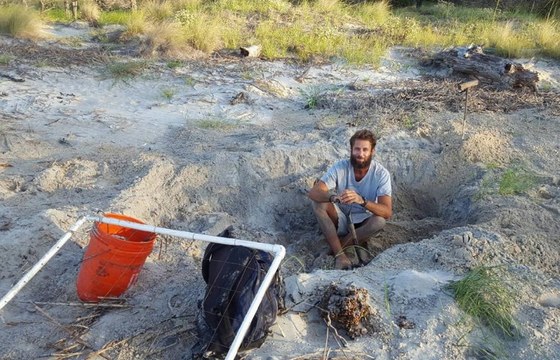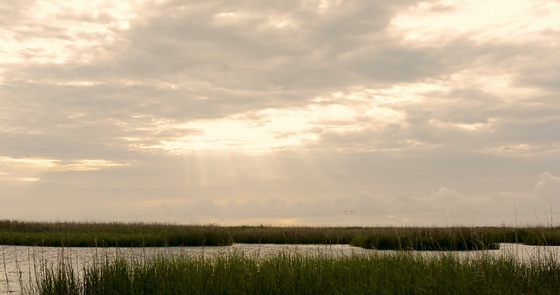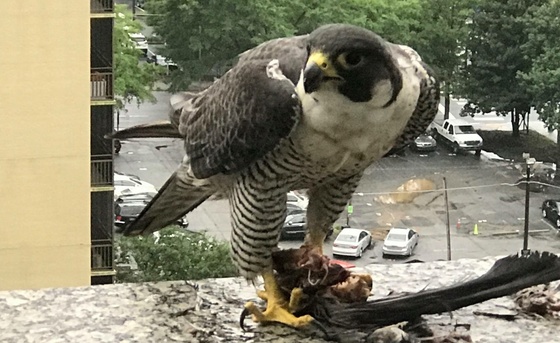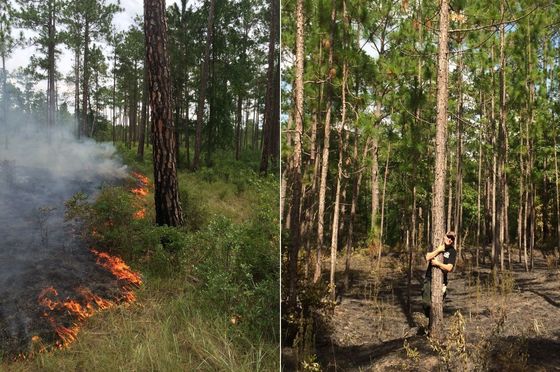IN THIS ISSUE
- Working the turtle beach
- Conserving Altamaha 'paradise'
- White-nose syndrome survey results
- How to sort out summer hummers
 Sea turtle tech Kyle Coleman searching for Ossabaw egg chamber
“By 7 a.m., I was positive today was going to be one of those days you just have to grit your teeth and get through. …”
What’s life like for DNR sea turtle techs working Georgia’s barrier island beaches? Find out this week as techs Jack Brzoza, Kyle Coleman and Sarah Martin blog about their jobs on Ossabaw and Little St. Simons.
It’s all part of #7Days4SeaTurtles, a weeklong, social media-based look at sea turtle conservation on Georgia’s coast.
Don’t miss a post: Follow the DNR Wildlife Resources Division on Facebook, Twitter, Instagram and Flickr. And the blog, of course.
P.S. The hatchlings are here!
WHAT YOU (ALSO) CAN DO
Conserving sea turtles and their habitats involves many agencies, organizations and volunteers. But helping goes beyond joining a group or working the beach.
A key way to contribute is through buying or renewing a DNR bald eagle or hummingbird wildlife license plate. Sales and renewals provide critical support for work with hundreds of Georgia wildlife and plant species that are rare or otherwise need conservation attention, including sea turtles.
DNR tags cost only $25 more than a standard license plate, and $19 of each purchase and $20 of each annual renewal goes to support conservation.
Learn how DNR is conserving wildlife, rare plants and habitats.
Back to top.
 Saltmarsh in Altamaha delta (Nicole Vidal/USFWS)
Georgia’s Altamaha River is a “blackwater beauty that nourishes longleaf pine forests, cypress swamps, saltwater estuaries and the barrier islands that protect the Atlantic coast and migratory birds alike.”
That’s one of the opening lines in “Conserving paradise,” the U.S. Fish and Wildlife Service’s multimedia journey into the heart of this corridor and what writer Dan Chapman calls “one of the nation’s most ambitious, successful and little-known conservation efforts” aimed at saving it.
Explore “Conserving paradise: the Altamaha River.”
Back to top.
 DNR's Cindy Alcazar swabs a tri-colored bat (Katrina Morris/DNR)
White-nose syndrome is a plague on bats.
Deadly and fast-spreading, the disease named for the snow-white fungus found on the muzzles and skin of some affected bats has killed more than 6 million bats in North America.
And that toll is rising, across the continent and in Georgia, where white-nose was documented in 2013.
Led by its Nongame Conservation Section, DNR is working to track and slow the advance of the disease and gauge its impact. Those efforts this winter are documented in a recently released report and an online story map.
For more:
SURVEY INSIGHTS
DNR wildlife biologist Katrina Morris commenting on WNS surveys this winter:
- “Last year we were seeing 50 percent declines in bat numbers at some sites, compared to the year before. This winter, we didn’t see those drastic declines.”
- “It seems like we’re getting to a point where we might not be seeing such major changes. But it’s also because we have fewer bats.”
- “We didn’t find white-nose in south Georgia. That’s a positive.”
Back to top.
 Male ruby-throated hummingbird (Todd Schneider/DNR)
By TERRY W. JOHNSON
Summer is the best time of year for Georgia hummingbird watchers. Some days, more than 100 hummers will visit a yard in search of nectar-producing flowers and sugar-water feeders.
At a distance, these birds can look the same. A closer look can reveal what appear to be at least three different kinds. And later in summer, an additional odd hummingbird or two can make identification even more confusing.
Most of these seemingly different birds are ruby-throated hummingbirds, our most common hummer. And a few tips can help you easily tell all of them apart. …
Read the rest of Terry’s column for ID insights, including sorting out any rare hummers that show up.
Terry W.
Johnson is a retired DNR nongame program manager and executive director of
TERN, Nongame
Conservation’s friends group. Read more in the Out My Backdoor
library, Terry's Backyard Wildlife
Connection blog and his new book, “A Journey of
Discovery: Monroe County Outdoors.”
Back to top.
 Confiscated wood duck and immature bald eagle (DNR)
A Bulloch County man and woman face misdemeanor charges after a dead bald eagle was found in their freezer. DNR Ranger 1st Class Jason Miller heard about the eagle, and that someone had asked about having it mounted. He and other DNR and Bulloch Sheriff’s staff questioned the couple last month, discovering the immature eagle and an illegally taken wood duck and two deer in a freezer. The investigation, including into how the eagle died, continues, according to Capt. Scott Klingel.
DNR’s Tom Patrick and fellow botanist Keith Bradley, who is doing work on national wildlife refuges along the coast, boated the lower Savannah River to search for rare plants on evergreen hammocks and bluffs. And they found them, discovering sites for the globally rare shrub silver buckthorn and Mellichamp’s skullcap, an uncommon mint.
None of the eight manatees fitted with satellite transmitters in late spring had lost their tags as of earlier this month, good news for the study of how manatees use Georgia’s coast (“Tracking more manatees,” June 15). In a recent check, all but two were between Cumberland Sound, Fernandina Beach and Naval Submarine Base Kings Bay, while one was in the Brunswick area and other near Port Orange, Fla.
 Peregrine at SunTrust Plaza Tower (Marc Bearden)
SunTrust Plaza Tower continues as a hangout for peregrine falcons, though no nest has been observed at the downtown Atlanta building for two years. Marc Bearden photographed this falcon outside a ninth-floor office in June.
Names in the news: Nongame Conservation Section Program Manager Dr. Brett Albanese spent four days on Paddle Georgia, this year a weeklong paddle on the upper Etowah River. Helped by DNR volunteer ichthyologist Camm Swift and The Nature Conservancy’s Katie Owens – plus many Paddle Georgia participants – Albanese made eight fish collections (collecting 37 species) and gave a short talk each night about ecology and conservation of the species. The 2018 event is set for June 16-22 on the Yellow and Ocmulgee rivers.
Back to top.
COMING UP
Aug. 21 – Ladies Day at the
Range, 10 a.m.-3 p.m., Wilson Shoals Wildlife Management Area
Shooting Range, Gainesville. Limited to 10 participants.
Sept. 23 – Monarchs Across
Georgia Pollinator Symposium, 9 a.m.-4 p.m., Monastery of the Holy
Spirit, Conyers
Sept. 28 – Georgia
Prescribed Fire Council annual meeting, UGA Tifton Campus Conference
Center, Tifton
Oct. 20 – Outdoor Learning
Symposium, Southwest Atlanta Christian Academy, Atlanta
WHAT YOU MISSED
… in the last Georgia Wild:
- A license change bonus for public lands
- Shadowing sparrows to save them
- Seen a spotted skunk? Let us know
Back to top.
"Seven right whales found dead in 'devastating' blow to endangered animal," The Guardian
"Help save the saltmarsh sparrow," Bryan County News
"Dead bald eagle found at Georgia home; 2 charged," The Atlanta Journal-Constitution
"Gopher frog conservation partner USFWS does incredible job in first season of head-starting," Amphibian Foundation
"Whale strikes, kills Canadian rescuer after he helps free it," The New York Times
"Man scared to leave house without helmet after hawk attacks," WSB-TV (Ch. 2, Atlanta)
"Alligator crushed by tree: Here's how it happened" on Wassaw National Wildlife Refuge, National Geographic
"Researchers have just discovered that frogs have knee caps," Science Alert, citing study in Acta Zoologica
Back to top.
 A growing-season burn covering about 300 acres at Broxton Rocks Preserve was a flaming success. The habitat-restoring prescribed fire involved DNR, The Nature Conservancy and Orianne Society staff, plus National Fish and Wildlife Foundation funding through The Longleaf Alliance. Because The Nature Conservancy, which owns the 1,650-acre southeast Georgia preserve, had strategically burned adjacent units in the dormant season, the recent burn was easier to manage despite its size and the high ambient temperature, reports DNR fire management officer Shan Cammack. Also at Broxton, Cammack (right) checked on longleaf pines she planted 25 years ago as a graduate student and Nature Conservancy volunteer. “So gratifying to see them grown up,” Cammack wrote.
Back to top.
|